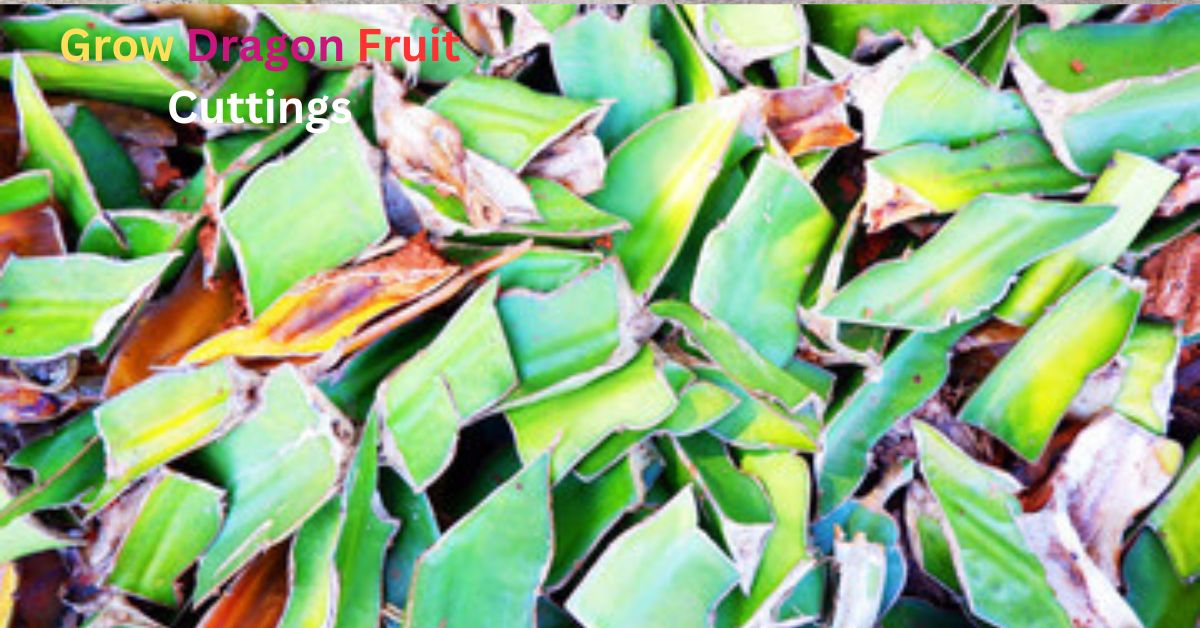
Dragon fruit, celebrated for its vibrant colors and exotic taste, has become a favorite among gardeners and fruit enthusiasts alike. If you’re considering growing this tropical delicacy, propagation through cuttings is the most efficient and reliable method. Here’s a comprehensive guide on why and how to grow dragon fruit from cuttings.
Why Choose Cuttings Over Seeds ?
Using cuttings to propagate dragon fruit offers several advantages:
1. Faster Growth:
- Cuttings bypass the seedling stage, allowing the plant to establish itself more quickly and produce fruit earlier.
2. Preserved Traits:
- Since cuttings are clones of the parent plant, they inherit all its characteristics. This ensures consistency in fruit quality, size, and flavor.
3. Higher Success Rate:
- Compared to seeds, cuttings have a significantly higher chance of rooting and thriving.
Choosing the Right Cutting
Selecting the right cutting is crucial for successful propagation. Here’s what to look for:
Maturity:
- Opt for a mature cutting from a healthy, established plant. Immature cuttings may struggle to root and grow.
Length:
- A cutting length of 12-18 inches is ideal. This size provides enough energy reserves for the plant to establish roots.
Nodes:
- Ensure the cutting has at least 2-3 nodes. Roots will develop from these nodes, making them essential for successful propagation.
Preparing the Cutting
Proper preparation increases the likelihood of rooting and growth. Follow these steps:
1. Sterilize Tools:
- Use clean, sterilized pruning shears to avoid introducing infections or diseases to the cutting.
2. Remove Leaves:
- Strip off the lower leaves to prevent rot. Leave only a few leaves at the top to support initial growth.
3. Optional Rooting Hormone:
- Dip the cut end in rooting hormone powder or gel. While not mandatory, this can accelerate root development.
4. Drying:
- Allow the cutting to dry for 1-2 days in a shaded area. This helps seal the cut end and reduces the risk of rot.
Rooting the Cutting
There are two primary methods for rooting dragon fruit cuttings: soil-based propagation and water propagation.

Method 1: Soil-Based Rooting
1 .Potting Mix:
- Use a well-draining mix. A combination of sand, compost, and garden soil works well.
2. Planting:
- Insert the cutting into the soil, ensuring at least one node is buried.
3. Environment:
- Place the pot in a warm, humid area with indirect sunlight. Avoid direct sunlight until the plant establishes roots.
4. Watering:
- Water lightly to keep the soil moist but not soggy. Over watering can lead to rot.
Method 2: Water Propagation
1. Water Jar:
- Place the cutting in a jar of water, submerging the nodes but keeping the leaves above the waterline.
2. Water Maintenance:
- Change the water every 2-3 days to prevent stagnation and root rot.
3. Root Development:
- Once roots are 1-2 inches long, transfer the cutting to a pot with well-draining soil.
Why Choose Cuttings Over Seeds ?
| Feature | Cuttings | Seeds |
| Growth Rate | Faster | Slower |
| Trait Preservation | Exact clones of parent plant | Genetic variation |
| Success Rate | Higher | Lower |
Transplanting the Rooted Cutting
Once the cutting has developed a healthy root system, it’s time to transplant it.
1. Choose the Right Pot:
- Select a pot slightly larger than the root ball to provide room for growth.
2. Prepare the Soil:
- Use a nutrient-rich, well-draining potting mix.
3. Planting:
- Position the cutting so the root ball is at the same depth as it was during propagation.
4. Watering:
- Water thoroughly after planting to help the roots settle into the new soil.

Caring for Your Dragon Fruit Plant
Providing proper care ensures your dragon fruit plant thrives and produces fruit. Follow these guidelines.
1. Sunlight:
- Dragon fruit plants require 6-8 hours of sunlight daily. Choose a bright spot with partial shade during the hottest part of the day.
2. Watering:
- Water regularly, but avoid over watering. The soil should remain slightly moist but never waterlogged.
3. Fertilizing:
- Apply a balanced fertilizer (10-10-10) every 2-3 months. During the fruiting season, switch to a fertilizer higher in phosphorus.
4. Pruning:
- Regularly prune to remove dead or damaged branches and shape the plant. This encourages healthy growth and better air circulation.
5. Pest and Disease Control:
- Inspect the plant for signs of pests like aphids or mealybugs. Use organic insecticides or neem oil if needed.
- Watch for diseases such as root rot or fungal infections and address them promptly.
Additional Tips for Success
1. Patience:
- Dragon fruit plants take time to mature and bear fruit. Be patient and consistent with care.
2. Climate Considerations:
- Dragon fruit thrives in tropical and subtropical climates. If you live in a colder region, consider growing it in a greenhouse or indoors.
3. Pollination:
- While some dragon fruit varieties are self-pollinating, others may require hand pollination. Having multiple plants can increase pollination success and fruit yield.
Enjoy the Fruits of Your Labor
With proper care and attention, growing dragon fruit from cuttings can be a rewarding experience. Not only will you enjoy the satisfaction of cultivating your own plant, but you’ll also get to savor the delicious fruits it produces. Follow this guide, and you’ll be well on your way to a thriving dragon fruit garden.




Pingback: Step-by-Step Guide to Planting Dragon Fruit Cuttings in 2024 -
Pingback: Cochineal Infestation